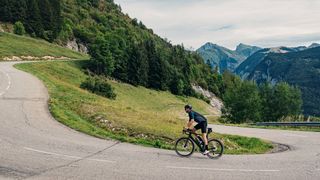Cycling as exercise: why you should get on your bike today
Does getting on your bike offer a good workout? We speak to a physiotherapist to look at the pros and cons of cycling as exercise

Cycling as exercise can be a great low-impact way to improve cardiovascular fitness, increase stamina, burn belly fat, strengthen the lower body and boost mental health. What’s more, the benefits are the same whether you are enjoying a ride outdoors, or on one of the best exercise bikes indoors.
“Cycling as exercise is a great way for all ages to get and stay fit, and train the cardiovascular system,” says chartered physiotherapist Damien Kelly, who works with professional athletes in Formula 1, golf and rugby and runs Physica Health Physiotherapy Clinic based in Surrey, U.K.
“It is low impact so it is kinder to joints than a lot of exercises, making it a good choice for beginners.”
In this article we look at the pros and cons of cycling as exercise, and find out more from Kelly about how an indoor or outdoor ride impacts our muscles, weight and knees.

Damien Kelly (MSc. MMT. MCSP. MACP. CSCS) is a specialist physiotherapist working in Formula 1, professional golf and pro rugby. He is also Director of Physical Health Physiotherapy Clinic based in Surrey, U.K. His areas of expertise include musculoskeletal injuries, sports performance, and rehabilitation.
Is cycling a cardio workout?
Cycling is not only a form of cardio workout, but one of the best, according to Kelly.
“It is primarily an aerobic, cardiovascular exercise, meaning it requires the heart and lungs to work hard to deliver oxygen-rich blood to the muscles in the lower limbs predominantly, so that they can do their job and propel the cyclist forward,” he says.
“This system is reliant on oxygen and it’s typically used in slower paced, endurance type efforts.
Cycling training can also be modified to have an anaerobic benefit, he continues. It increases the body's ability to create and use energy to provide power without the presence of oxygen by burning glucose instead to form adenosine triphosphate (ATP).
“The anaerobic system is capable of producing lots of power very quickly but is not sustainable for long due to a build-up of lactic acid and other by-products,” Kelly explains. “This system is used in fast, high-power activities such as weight lifting, sprinting and cycle-sprints.
“To use the anaerobic system while cycling, you can train using short high effort intervals, do hill climbs, or increase the resistance for short periods on a stationary bike.”

When cycling, what muscles are used?
As you’d expect, the main muscles used for cycling are those in the legs.
“When seated and performing the downstroke of pedaling, the main muscles being used are the quadriceps (front of thighs), calf muscles and glutes. On the upstroke, the hamstrings (back of thighs), and hip flexors (front of hips) will be working hard against resistance,” explains Kelly.
Will cycling build muscle?
Yes and no, says Kelly. “Cycling will build muscle to an extent but how much [it will do so] will be determined by the frequency of training and how much resistance is used.
“The best ways to speed up muscle building from cycling is to train frequently (three to four times a week), with repeated short, high intensity, high resistance efforts, with a moderate to high resistance.
“Muscles need repeated overload in this fashion – a fitness principle known as progressive overload – to be forced to adapt and grow. Long, low intensity efforts will be less effective for muscle building as this lacks the resistance needed to 'overload' the muscles.”

Is cycling good for weight loss?
Cycling is a great method of weight loss, says Kelly. “As a form of aerobic cardiovascular exercise, it will prompt the body to burn fat as a fuel source especially for longer periods on the bike,” he adds.
The US Department of Health and Human Sciences recommends 300 minutes-a-week of cycling or other forms of cardiovascular exercise in order to achieve the greatest benefits in weight loss. But it’s not just as simple as jumping on the bike and getting the body of your dreams, Kelly says.
“As the saying goes: you 'can't out-exercise a bad diet’, meaning the body needs to be in a calorie deficit in order to achieve weight loss. Combining a regular cycling routine with a healthy, low-moderate calorie diet will put you in the best position to achieve success in the pursuit of losing weight.
“The aim of a nutritionally balanced diet is not to restrict calories but to ensure that any calories taken in are full of the vitamins and macro nutrients that we need to perform at our best. Tools such as the "MyPlate Plan" provided by the USDA can be a helpful addition to your weight loss strategy.”
Is cycling bad for knees?
If you suffer from knee or joint issues then cycling as exercise could be a good option, especially compared with running, Kelly says.
“Cycling is low impact and kind to the knee joints with the added benefit of being able to adjust resistance and seat height to comfort. Stationary exercise bikes can be even more adjustable and a safer way to start as there are never any unexpected hills to deal with!
“When you do have to cycle outdoors however, a flat concrete road will provide a more consistent and easier surface to pedal on than gravel or more rugged terrain where more pressure will need to be exerted on the knee joints to keep those pedals moving.”

What equipment do you need?
If you’re training indoors, you’ll need a road bike with a turbo trainer (a static device that connects to the bike to provide resistance) or an exercise bike. Static exercise bikes will vary in price depending on factors like whether they have smart features, but you can pick up on of the best budget exercise bikes for a few hundred dollars. If you’re outside, you just need your bike, a helmet and a water bottle, says Kelly.
Pros and cons of cycling as exercise
One of the pros of cycling as exercise is highly adaptable. “You can cycle as hard or as lightly as you choose depending on your effort, choice of gears or terrain. And you can explore the outdoors, which studies have shown is beneficial for mental health.”
A huge 2018 study published in the Lancet analyzed the exercise and mental health of 1,237,194 adults using three years of survey data where participants logged the type of exercise, how much they exercised, how many days they experienced poor mental health (stress, depression, other emotional issues).
Out of the 75 exercises studied, riding a bike – both indoors and outside – came second with participants reporting 21.6 percent fewer days of poor mental health than non-exercisers. Team sports were the best type of training to boost emotional wellness.
The downside of cycling is it’s mainly a lower body workout, can be expensive if you need to buy a high performance bike or exercise bike, and wouldn’t be the best choice if muscle building is your main goal, says Kelly.
Sign up for the Live Science daily newsletter now
Get the world’s most fascinating discoveries delivered straight to your inbox.
Maddy has been a writer and editor for 25 years, and has worked for some of the UK's bestselling newspapers and women’s magazines, including Marie Claire, The Sunday Times and Women's Health. Maddy is also a fully qualified Level 3 Personal Trainer, specializing in helping busy women over 40 navigate menopause.

